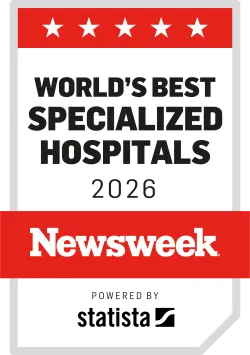Breadcrumb
- Home
- Conditions & Treatments
- Fatty Liver
What is fatty liver disease?
Fatty liver disease, also called non-alcoholic fatty liver disease (NAFLD), is a type of liver disease that happens when excess fat is stored in the liver.
NAFLD is one of the most common causes of liver disease and affects approximately 10 percent of cases. The condition is most common in Hispanic children, followed by children who are Caucasian. It is least common among African American children.
More boys than girls develop NAFLD. Certain conditions also make children more likely to develop fatty liver disease.
There are two types of fatty liver disease:
- Simple fatty liver disease, when a child has accumulated fat in the liver but no inflammation or cell damage.
- Non-alcoholic steatohepatitis (NASH), when fat in a child's liver leads to inflammation and cell damage. NASH is a serious condition that can lead to cirrhosis or liver cancer.
Symptoms & Causes
What are the symptoms of fatty liver disease?
NAFLD and NASH are considered silent diseases because they often have no symptoms. For many children, the only symptoms are feeling tired or having discomfort in the upper right abdomen.
What causes fatty liver disease?
Researchers do not fully understand why some children develop NAFLD. They do know that it is more common in children with certain conditions. These conditions include:
- Obesity
- Type 2 diabetes and prediabetes
- High lipid disorders
- Insulin resistance
- Hepatitis C
- Rapid weight loss
Diagnosis & Treatments
How is fatty liver disease diagnosed?
A child's doctor will usually make a diagnosis of non-alcoholic fatty liver disease (NAFLD) based on a combination of medical history, physical examination and blood tests. Children who are obese and have higher-than-normal levels of certain liver enzymes on routine blood tests are more likely to have NAFLD.
The doctor may order an ultrasound (a painless, non-invasive imaging technique that uses high-frequency sound) sound to look at the structure of the liver. In addition, the doctor may order a transient elastography (FibroScan), which measures ultrasound waves through the liver to predict liver stiffness/scarring and the amount of liver fat.
In some cases, the doctor may order a needle biopsy to look for signs of fat buildup and scarring in the liver. This will tell whether a child has simple nonalcoholic fatty liver disease (NASH) or non-alcoholic steatohepatitis (NASH).
If a child is diagnosed with NAFLD, doctors will monitor the child’s liver by several means, including periodic:
- Blood tests, to check how well your child’s liver is working
- Ultrasounds
- Transient elastography
- Physical exams
How is fatty liver disease treated?
There is no simple cure for NAFLD. The focus of treatment is to prevent the disease from getting worse. This includes:
- Encouraging healthy eating and weight loss
- Maintaining tight control of blood sugar levels for children with diabetes
- Monitoring the child for complications or progression from NAFLD to more severe NASH
Some early studies suggest that vitamin E, an antioxidant, may have some benefit. However, it should not be seen as a substitute for weight loss, healthy eating, and physical activity.
What is the long-term impact of NAFLD in children?
Because NAFLD is a chronic condition, a child with the condition may have to seek regular care for their entire lives.
If NAFLD advances to NASH, the liver may start to scar. Scar tissue can replace the liver’s healthy, soft tissue, causing cirrhosis and preventing the liver from working properly. If not brought under control, cirrhosis can lead to complications including portal hypertension, as well as liver failure or liver cancer, and may require liver transplantation. All of these are serious but preventable conditions as long as the buildup of fat in the liver and the process of scarring can be slowed or stopped.
How we care for NAFLD
At Boston Children's Hospital, we take a multidisciplinary approach to the care of children with NAFLD. Our Center for Childhood Liver Disease is one of the few centers in the country with a dedicated team of specialists who are board-certified in pediatric hepatology.
Our team of pediatric liver doctors, dietitians, nurses, and administrative staff is dedicated to the care of children with confirmed or suspected fatty liver disease. We use specialized non-invasive imaging tests, like the FibroScan, to help estimate the degree of scarring and fat in the liver and to help manage the fatty liver disease.
In addition, we work closely with the other specialty programs at Boston Children’s to ensure each child receives comprehensive care. The Division of Gastroenterology, Hepatology and Nutrition takes a multidisciplinary approach to the evaluation and management of fatty liver disease.
Because obesity is a significant risk factor for many conditions, including NAFLD, Boston Children’s offers five hospital-based programs to help children and their families manage their weight.
- Optimal Wellness for Life (OWL) Program: The largest pediatric weight management clinic in New England, it treats overweight children between ages 2 and 20.
- The One Step Ahead program: Focused on prevention and management, this program treats 3- to 13-year-olds who are part of the Children's Hospital Primary Care Center (CHPCC).
- STEP: Based in the Division of Adolescent/Young Adult Medicine, this program works with 13- to 25-year-olds to develop a teen- and young adult-friendly approach to weight and lifestyle management.
- Preventive Cardiology Clinic (Lipid Clinic): A preventive cardiology program that serves patients who have elevated lipid levels and hypertension.
- Adolescent Weight Loss (Bariatric) Surgery Program: A program for adolescents who are considering surgical interventions to reduce weight.


